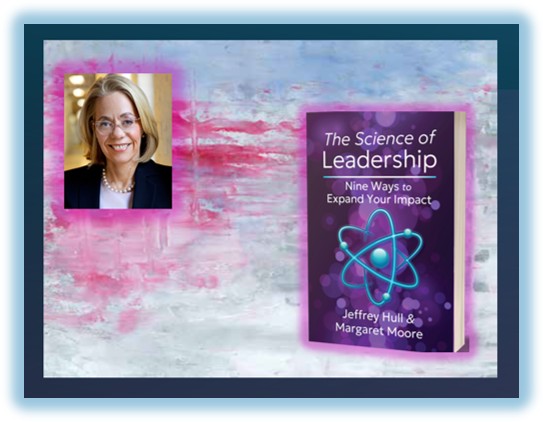
The Science of Leadership: Nine Capacities to Navigate Complexity and Drive Impact

In an era of unprecedented challenges—from AI-driven disruptions to economic volatility and bureaucratic inertia—effective leadership demands more than intuition or charisma. It is no longer about hierarchy or control; it is about adaptability, empathy, and the deliberate cultivation of human potential and it requires a rigorous, evidence-based approach grounded in scientific research. This is the core message of The Science of Leadership: Nine Ways to Expand Your Impact,co-authored by Margaret Moore and Dr. Jeff Hull.
In a recent episode of The Business of Government Hour, I had the pleasure of speaking with Margaret Moore, a biotech executive turned leadership coach and founder of the Institute of Coaching at McLean Hospital, about the critical insights from her book. Drawing from over 15,000 studies synthesized into a practical framework, Moore shows how leaders can cultivate nine essential capacities across three levels -- self-oriented, other-oriented, and system-oriented – to be more effective and impactful. Her insights, grounded in psychology, neuroscience, and real-world practice, are particularly relevant to public sector leaders who must balance mission delivery with employee engagement, morale, and organizational transformation.
This essay explores the key insights and core themes from my conversation with Margaret. It examines how these capacities enable leaders to bridge the gap between theory and practice, particularly in high-stakes environments like government.
Recasting the Concept of Leadership
Leadership is one of the most written about disciplines in modern organizational life. For decades, we’ve tried to reduce it to lists of traits—vision, charisma, decisiveness—or to neat binaries: autocratic versus democratic, servant versus transformational, transactional versus inspirational. Yet these framings feel increasingly outdated in a world where disruption is constant, workforces are hybrid, and employees are no longer willing to sacrifice well-being for wealth.
What if leadership is not a static identity, but a set of capacities -- skills that can be taught, practiced, and refined like any other discipline? And what if the key lies in learning to dial those capacities up or down, in the right balance, depending on the moment?
Quieting the Ego Noise
The starting point is not external strategy but internal discipline. Every leader, regardless of industry or sector, knows the chatter that fills the mind before a high-stakes meeting or decision: insecurity, defensiveness, comparison. Moore calls this “ego noise”—a mental static that clouds judgment and prevents leaders from attending to what really matters.
Neuroscience shows that when leaders are consumed with themselves, the brain’s prefrontal cortex—the seat of empathy, perspective-taking, and executive function—literally shuts down. In contrast, leaders who learn to quiet ego noise create space for genuine listening, connection, and creativity. The shift may sound simple, but its impact is profound: when the focus moves away from self, energy becomes available for others and for the larger system.
The Three Orientations of Leadership - Bridging Science and Real-World Leadership
Moore's journey into leadership science began with a pivot from biotechnology to coaching. As she explained, "My first career was in biotechnology. I'm a biologist with an MBA... I have a deep respect and love for the scientific process." Frustrated by the lack of empirical rigor in coaching and leadership models, she and her co-author Dr. Jeff Hull reviewed vast bodies of research—often meta-analyses of hundreds of studies—to distill actionable insights.
This brings us to the heart of their new model: leaders operate across three orientations-self-oriented, other-oriented, and system-oriented capacities. As she explains: “Self-oriented leadership is where you are doing your own work, for yourself. Other-oriented leadership is where you’re leading a team. And system-oriented leadership is where you’re leading a whole system.”
- Self-oriented capacities involve self-regulation, resilience, and ego management. They are the foundation: without inner steadiness, leaders cannot hold the turbulence of external change.
- Other-oriented capacities include empathy, listening, coaching, and enabling others’ growth. This is where servant leadership comes alive—not in self-abnegation, but in fostering conditions where others can thrive.
- System-oriented capacities require the ability to see patterns, connect silos, and drive systemic transformation. Here the leader is not only solving for today’s team dynamics, but for the organizational architecture of tomorrow
Effective leadership, then, is not choosing among these orientations, but integrating them. The art lies in knowing which to dial up, when, and by how much.
Dialing the Capacities
Perhaps the most powerful metaphor for leadership science is that of an audio mixing board. Each capacity—humility, courage, empathy, disruption, stability—is a dial. Too much humility in a crisis can look like weakness; too much disruption in a fragile moment can breed chaos. Leadership requires knowing how to tune the balance, moment by moment, like music.
This reframing relieves leaders of the impossible burden of perfection. No one is always visionary, always decisive, always empathetic. What matters is awareness, experimentation, and responsiveness. Leaders become less like statues and more like jazz musicians: improvising, adapting, and attuning to the context.
Leadership as a Teachable Discipline
If leadership is truly a set of capacities, then it can—and must—be taught. Too often, organizations assume leadership emerges organically: a talented employee is promoted, attends a few workshops, and is expected to “figure it out.” But imagine if we treated leadership like medicine, law, or engineering—disciplines grounded in science and honed through practice. This shift has both urgency and scale.
Technology, paradoxically, may be the breakthrough. Artificial intelligence can help democratize leadership training—acting as an on-demand coaching assistant that contextualizes principles, quiets ego noise in the moment, and scales evidence-based practices to millions who would otherwise lack access. Leadership science can, with the right application of AI, become a universal discipline.
Servant, Transformational, and Authentic Leadership—Reframed
One of the traps of past leadership literature has been the tendency to treat models as competing schools. In reality, the science suggests that servant, transformational, and authentic leadership are not mutually exclusive—they are complementary capacities to be dialed in balance.
- Servant leadership reminds us that leadership is not about the leader but about the people and purpose being served. In public service especially, this ethos remains strong and deeply motivating.
- Transformational leadership pushes beyond service to catalyze change. It is not enough to preserve; leaders must disrupt outdated practices, expand mindsets, and reimagine systems.
- Authenticity, meanwhile, has often been misconstrued as self-expression. The deeper science reframes it: the leader’s job is not only to “be authentic” but to create conditions in which others feel safe to be authentic themselves.
Together, these modes form a triad of service, transformation, and authenticity that leaders can orchestrate like instruments in a symphony.
The Neuroscience of Agility
Agility has become a buzzword in leadership discourse, but neuroscience grounds it in something very specific: the brain’s capacity to shift quickly between mental states. Leaders today must constantly switch from analytical to relational, from stabilizing to disruptive, from detailed to systemic. This cognitive flexibility requires energy—and, like any muscle, it fatigues.
That is why resilience practices matter. Rest, recovery, and reflection are not indulgences; they are prerequisites for leaders to maintain the neural bandwidth required for agility. Without them, decision-making becomes rigid, reactive, and defensive, the very opposite of what disruption demands.
The Hybrid Work Paradox
Nowhere are these capacities tested more acutely than in the debate over hybrid work. Leaders push for in-office presence to drive creativity and innovation. Employees push back, citing health, well-being, and balance. Though there is little evidence that five days in the office improves performance, employees are equally right that remote work alone can fray culture and collaboration.
The answer is not either/or but both/and. Hybrid work requires leaders to facilitate genuine dialogue between management and employees, listening deeply to the underlying needs on both sides: the organization’s need for innovation and the workforce’s need for well-being.
The opportunity is to redefine the office not as a default location for solitary tasks, but as a hub for the kinds of activities that thrive in physical proximity—creative problem-solving, social bonding, and trust-building. At its best, hybrid work can deliver on both: the productivity leaders seek and the well-being employee’s demand.
Practical Exercises: Expanding Leadership Capacities
Margaret emphasizes actionable strategies for leaders seeking to enhance their impact immediately. She frames leadership as an expansion of self, not a search for a fixed identity. One simple exercise involves pausing before key decisions or meetings to assess which leadership capacity is required—agility, relational skill, transformational influence, or mindfulness:
“You pause and you say, which do I need right now and you just take that in and then bring that into your next task.”
This approach empowers leaders to respond adaptively, rather than relying on habitual or reactive behaviors. For government executives, it encourages context-sensitive leadership, enabling nuanced responses to crises, stakeholder concerns, and rapidly shifting priorities.
Integration: Leadership as an Art and Science
The Hull-Moore framework emphasizes that leadership is both art and science. Evidence-based capacities—alignment, competence, quiet ego, relational and transformational skills, system-oriented awareness—must be applied creatively, tuned to context, and constantly recalibrated. For government executives, this translates into a practical roadmap:
- Assess alignment between employees’ values and organizational purpose.
- Celebrate competence to build confidence and resilience.
- Cultivate quiet ego to reduce fear-driven decision-making.
- Leverage system-oriented capacities to integrate diverse perspectives.
- Adopt hybrid work solutions to balance productivity and well-being.
- Incorporate evidence-based, scalable leadership development programs.
- Contextually modulate capacities to match situational demands.
- Prioritize service and mission as foundational motivators.
When applied collectively, these principles create a leadership culture capable of driving transformation.
Toward a Science of Leadership
Leadership, at its core, is not charisma, personality, or luck. It is a discipline grounded in science—of the brain, of human behavior, of systems. It is teachable, practicable, and scalable. The leaders of tomorrow will not be defined by whether they fit a single archetype but by their ability to dial capacities up or down, in balance, in context, and in service of both people and systems.
According to the authors of The Science of Leadership, the opportunity is clear: to quiet the ego noise, attune to others, and orchestrate leadership as music. When we learn to do this, we will no longer ask whether leaders are born or made. We will know they are trained, disciplined, and capable of composing the symphony these turbulent times demand.
Conclusion
The Hull and Moore approach to leadership combines rigorous scientific grounding with deeply humanistic principles. It is a blueprint for navigating complexity, promoting engagement, and balancing organizational goals with employee well-being.
For public sector leaders, the insights shared by Margaret on The Business of Government Hour and outlined in her new book with Dr. Jeff Hull, offer both practical exercises and strategic perspectives. Their vision redefines leadership for the modern era, showing that when leaders apply science, psychology, and empathy, they can drive meaningful change. Leadership starts with self-mastery before extending to others and systems. As Moore put it, "Everybody has to do that [lead themselves]. So that's the starting point."



